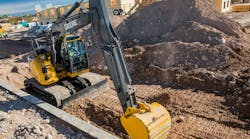Fleet-asset managers’ top challenge this year is not being able to replace equipment as needed. That response came according to our recently completed subscriber survey, in which we asked Construction Equipment subscribers for their Top 3 challenges of the year.
Top 3 Challenges Facing
Equipment Managers
- Not able to replace equipment as needed
- Lack of skilled operators
- Lack of skilled technicians
Source: Construction Equipment magazine
You have to be careful about the reasons driving that choice, but it’s fair to say the dismal economy and slow-to-recover construction markets are having an effect. Summer’s slowing mining market provided an excellent example of demand’s affect on supply, as mining companies cut capital investments in equipment and publically traded equipment manufacturers lowered sales expectations.
For equipment managers, this is a critical issue. They must balance the financial risks in repair and replace decisions. For almost five years, fleets have been trying to extend machine life without jeopardizing their organizations’ cost structure. Senior management has, rightfully, cast a discerning eye on expenditures. Equipment budgets have been scrutinized and, no doubt, reduced.
After five years of this, the equipment side of construction should have some strategies in place.
First, equipment managers must be ready as demand for new equipment is unleashed when the cycle returns the industry to health. Equipment budgets will not be able to absorb all the costs of replacing aging equipment at once. Managers must have priorities in place, and they must have a financial plan in place to support them.
Second, purchasers have to understand technological improvements in equipment, such as telematics and emissions. Machines have advanced tremendously in the past five years. As manufacturers have implemented new emissions aftertreatment and chemistry, machine engineering has changed. As telematics systems have become more integrated and sophisticated, the amount of information and data has increased. Each of these alone would cause changes in machine management, especially the management of maintenance programs. Together, telematics and emissions compliance have the potential to alter the status quo on equipment management.
Construction markets will return, and equipment demand will follow. Prepare now with the strategies to succeed when it happens.





